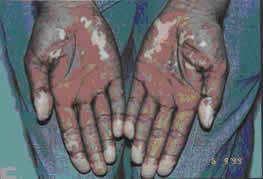Introduction
Occupational skin diseases are skin diseases caused by exposure to hazardous agent/substance present at workplace.
Examples of occupational skin diseases are: (Refer table)
| Occupational Skin Diseases | Features | Common Hazardous Agent |
|---|---|---|
| Occupational contact dermatitis |

|
Dyes, rubber, formaldehyde, flour, pesticide, formaldehyde, solvents, cement, detergent, diesel, paraffin, thinner. |
| Occupational skin cancer |

|
Radiation, soot, tar, mineral oils |
| Occupational acne |

|
Oil,grease |
| Occupational leucoderma (vitiligo) |

|
Phenols, hydroquinone |
Prevention
How to prevent occupational skin disease?
- Avoid direct contact with hazardous agent which has been identified to cause skin disease to yourself.
- Practice personal cleanliness. Always wash exposed body parts (hands, face) following contact with hazardous chemical or agent at workplace.
- Use sun screen for outdoor workers to protect from ultraviolet light)
- Use of personal protective equipment to prevent direct contact with hazardous agent. Examples are gloves, face mask,long sleeve shirt, long pants, apron.
- Seek early medical advise if you think you have skin disease associated with work.
- Report to employer about the disease so that suitable control measures can be taken to improve the working condition
Investigation
How occupational skin disease is confirmed?
- Disease normally improves with absence from work and recur on returning to work.
- Specific test such as skin patch test and skin biopsy (part of the affected skin is taken for microscopic examination)
Treatment
What is the treatment for occupational skin disease?
Treatment depends on:
- Type of skin disease
- Severity of disease
The most important measure to prevent recurrence of disease is to avoid further exposure to the hazardous agent, you might also be given certain medication to relieve the symptoms. In cancer cases, surgery to remove the skin cancer need to be done.
Notification
According to Occupational Safety and Health (Notification of Accident, Dangerous Occurrence, Poisoning and Occupational Diseases) Regulation 2004, it is the responsibilities of :
- Employer
- Attending medical practitioner
To notify occupational diseases to Department of Occupational Safety and Health.
Contact address
For further information, please e-mail to: ohealth@dph.gov.my
| Last Reviewed | : | 25 April 2012 |
| Writer | : | Dr. Sirajuddin Hashim |
| : | Dr. Nor’Aishah Abu Bakar | |
| : | Dr. Abu Hassan Shaari Abd Kadir | |
| Reviewer | : | Datin Dr. Asmah Johar |







